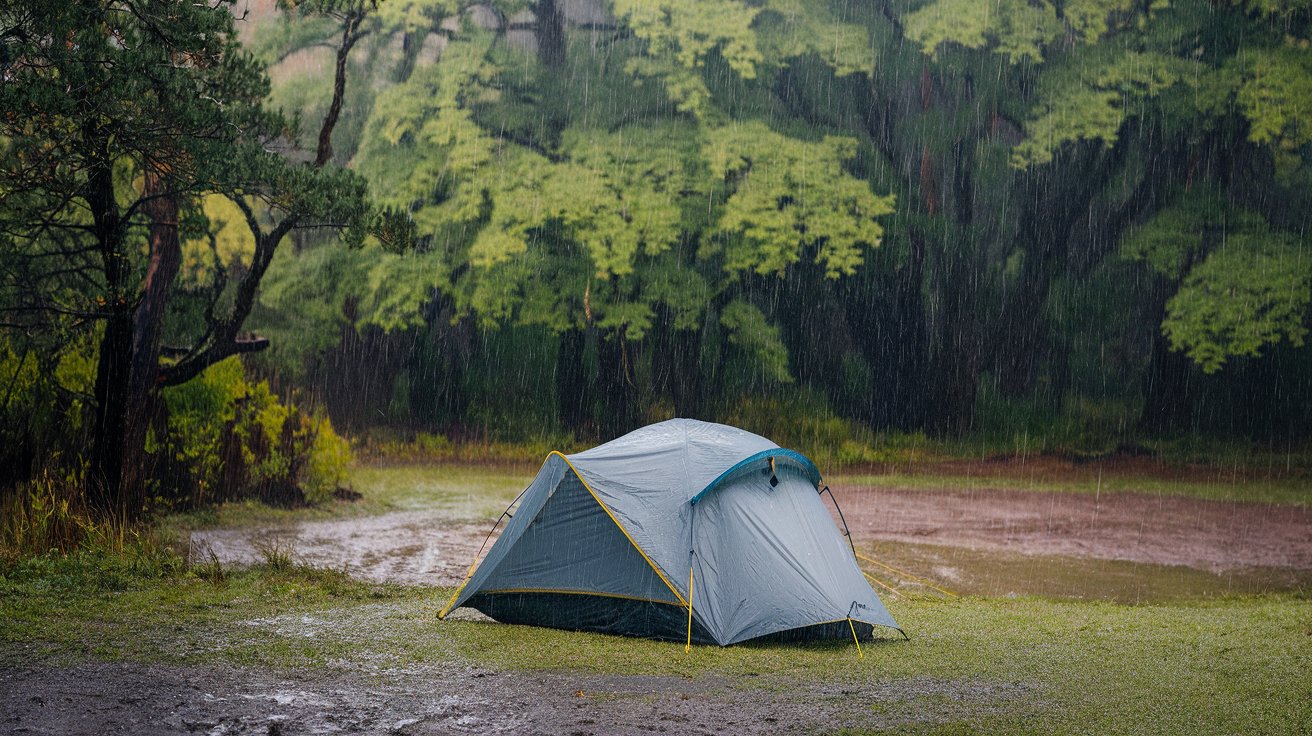<script type="text/javascript" src="http://classic.avantlink.com/affiliate_app_confirm.php?mode=js&authResponse=c4e13e1b9b5acdedad16d533a16f7bf0c234d607"></script>
<script type="text/javascript" src="http://classic.avantlink.com/affiliate_app_confirm.php?mode=js&authResponse=c4e13e1b9b5acdedad16d533a16f7bf0c234d607"></script>

Nothing ruins a camping trip faster than waking up in a soaking wet tent. Even the best tents can lose their waterproofing over time, leading to leaks, condensation, and damp gear. Properly waterproofing your tent ensures you stay dry and comfortable in heavy rain.
In this guide, we’ll walk you through how to waterproof your tent, covering essential steps like seam sealing, applying a durable water repellent (DWR) coating, and choosing the right tent footprint. If you need a new rainproof tent, check out our Best Tents of 2025 for expert recommendations.
🔹 Pro Tip: Even if your tent is labeled waterproof, it’s a good idea to reapply waterproof coatings every season for maximum protection.
Before heading into the wild, set up your tent in your backyard or a dry area and check for weak spots:
✔ Spray the tent with water to see where leaks occur.
✔ Check seams and corners—these are common leak points.
✔ Inspect the rainfly and floor for signs of wear or flaking waterproof coating.
🔹 Pro Tip: If you see water absorbing into the fabric instead of beading up, your tent needs waterproofing treatment.
Most tents come with factory-sealed seams, but over time, the seam tape can peel away, causing leaks.
🔹 Recommended Product: Gear Aid Seam Grip WP – Works on most tent fabrics and provides long-lasting waterproofing.
👉 Pairs well with: Best 4-Season Tents of 2025 for extreme weather camping.
Over time, the outer fabric of your tent can lose its ability to repel water, leading to damp walls and condensation. Reapplying DWR restores this protective coating.
🔹 Recommended Product: Nikwax Tent & Gear SolarProof – Adds UV and water protection to tent fabric.
👉 Pairs well with: Best Backpacking Tents of 2025 to keep gear protected on long hikes.
The tent floor is the most vulnerable area for leaks since it sits directly on wet ground. A tent footprint adds an extra layer of protection.
✔ Choose a footprint slightly smaller than your tent’s base to prevent rain from pooling underneath.
✔ Use a waterproof tarp if a dedicated footprint isn’t available.
✔ Check for holes or tears in older footprints and replace if needed.
🔹 Recommended Product: GEERTOP Waterproof Tent Footprint – Lightweight, durable, and easy to pack.
👉 Pairs well with: Best Sleeping Pads of 2025 to keep moisture away from your sleeping gear.
Your rainfly is your tent’s first line of defense against heavy rain. Over time, it can lose its waterproof coating, leading to leaks and water pooling.
🔹 Recommended Product: Kiwi Camp Dry Heavy-Duty Water Repellent – Works great on rainflies and backpacks.
👉 Pairs well with: Best Camping Gear of 2025 for a fully weatherproof setup.
✔ Set up your tent on higher ground to avoid water pooling.
✔ Angle the rainfly properly to direct water runoff away from the tent.
✔ Use extra guy lines to keep the tent stable in windy, rainy conditions.
✔ Keep wet gear outside in the vestibule to prevent condensation buildup inside.
🚫 Skipping seam sealing on a new tent.
✅ Solution: Even if factory-sealed, check and reseal seams periodically for better protection.
🚫 Using the wrong waterproofing spray.
✅ Solution: Always choose a DWR treatment designed for tent fabric.
🚫 Packing a wet tent.
✅ Solution: Let your tent fully dry before storing it to prevent mildew and damage.
❓ How often should I waterproof my tent?
👉 Every 1-2 years, or as soon as you notice water absorbing instead of beading on the fabric.
❓ What’s the best waterproofing spray for tents?
👉 Nikwax Tent & Gear SolarProof is a top choice for long-lasting rain protection.
❓ Do I need to seal my tent seams if they look fine?
👉 Yes! Even if your tent seems watertight, reapplying seam sealer ensures no leaks develop over time.
Properly waterproofing your tent is essential for staying dry and comfortable in heavy rain. With the right techniques—seam sealing, DWR treatment, and using a footprint—you can ensure your tent remains stormproof for years to come.
Looking for a new waterproof tent? Check out our Best Tents of 2025 for expert recommendations, and don’t forget to upgrade your gear with a Sleeping Pad and Backpacking Rain Jacket for full weather protection!